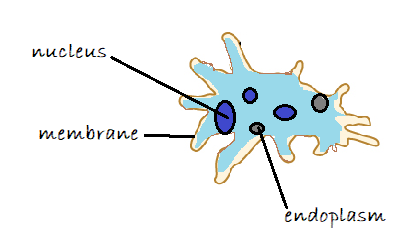
What does the word pseudopodia mean?
A. Hidden arm
B. False foot
C. Soft-bodied
D. Multi limbed
Answer
552.9k+ views
Hint:Amoeboid movement is performed by pseudopodia and requires cytoplasm flow as the organism's extensions. As a movement of granules inside the body, the mechanism is evident under the light microscope. Pseudopodium is the essential locomotory organelle.
Complete answer:Pseudopods can be observed in a variety of leukocytes (phagocytic cells) in higher animals that use the structure to trap invading microbes and kill them. There are four major types, depending on the cell type, which not only varies in appearance (and overall morphology) but also has different functions. For example, pseudopods contain microtubules in certain species that contribute significantly to the movement of cells.
Slender actin-based structures that represent sensory and locomotory roles are Filopodia. Filopodia, like other pseudopods, are cellular protrusions and thus extend from the surface of the cell. However, filopodia are mainly present in certain cells of multicellular organisms compared to pseudopods present in single-celled organisms where they reach into the extracellular matrix and are involved in signaling.
Axopodia are long and thin protrusions from the cells, much like filopodia. They are, however, more rigid (and therefore appear needle-like) than filopodia, which in nature tend to be more flexible. They can be found on the cell surface of different species where they are involved in feeding and locomotion.
Often referred to in some books as rhizopodia (or extrathalamous cytoplasm), reticulopodia are thread-like pseudopodia that branch and fuse to form a highly dynamic network. As is the case with axopodia, tubules and the cytoplasm often consist of reticulopodia.

Hence the correct answer is option B, False foot.
Note: An Amoeba is a concept commonly used to describe a single-celled eukaryotic organism that travels through pseudopodia and has no definite form. Pseudopodia or pseudopods are temporary cell projections and the term means "false feet" literally. As a means of locomotion, the cell utilizes the pseudopodia.
Complete answer:Pseudopods can be observed in a variety of leukocytes (phagocytic cells) in higher animals that use the structure to trap invading microbes and kill them. There are four major types, depending on the cell type, which not only varies in appearance (and overall morphology) but also has different functions. For example, pseudopods contain microtubules in certain species that contribute significantly to the movement of cells.
Slender actin-based structures that represent sensory and locomotory roles are Filopodia. Filopodia, like other pseudopods, are cellular protrusions and thus extend from the surface of the cell. However, filopodia are mainly present in certain cells of multicellular organisms compared to pseudopods present in single-celled organisms where they reach into the extracellular matrix and are involved in signaling.
Axopodia are long and thin protrusions from the cells, much like filopodia. They are, however, more rigid (and therefore appear needle-like) than filopodia, which in nature tend to be more flexible. They can be found on the cell surface of different species where they are involved in feeding and locomotion.
Often referred to in some books as rhizopodia (or extrathalamous cytoplasm), reticulopodia are thread-like pseudopodia that branch and fuse to form a highly dynamic network. As is the case with axopodia, tubules and the cytoplasm often consist of reticulopodia.

Hence the correct answer is option B, False foot.
Note: An Amoeba is a concept commonly used to describe a single-celled eukaryotic organism that travels through pseudopodia and has no definite form. Pseudopodia or pseudopods are temporary cell projections and the term means "false feet" literally. As a means of locomotion, the cell utilizes the pseudopodia.
Recently Updated Pages
Master Class 12 Business Studies: Engaging Questions & Answers for Success

Master Class 12 Economics: Engaging Questions & Answers for Success

Master Class 12 English: Engaging Questions & Answers for Success

Master Class 12 Maths: Engaging Questions & Answers for Success

Master Class 12 Social Science: Engaging Questions & Answers for Success

Master Class 12 Chemistry: Engaging Questions & Answers for Success

Trending doubts
Which places in India experience sunrise first and class 9 social science CBSE

Fill the blanks with the suitable prepositions 1 The class 9 english CBSE

Write the 6 fundamental rights of India and explain in detail

Difference Between Plant Cell and Animal Cell

What is the Full Form of ISI and RAW

Golden Revolution is related to AFood production BOil class 9 social science CBSE




